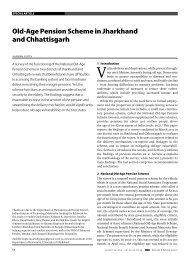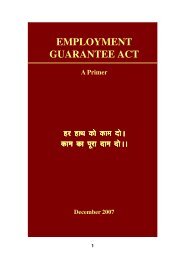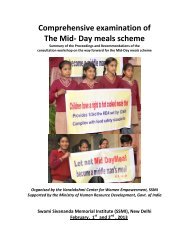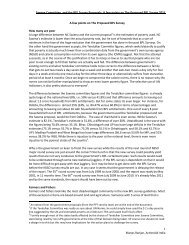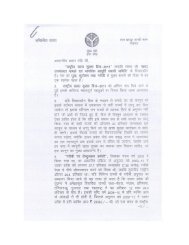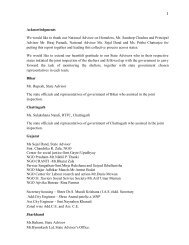NREGA: Opportunities and Challenges - Diksha
NREGA: Opportunities and Challenges - Diksha
NREGA: Opportunities and Challenges - Diksha
Create successful ePaper yourself
Turn your PDF publications into a flip-book with our unique Google optimized e-Paper software.
<strong>NREGA</strong>: OPPORTUNITIES AND CHALLENGEScent was worked upon for soil conservation. “We have, in these years of scarcity, used funds to plan forrelief against drought,” says Patil.The impact is tangible, say officials, citing three indicators. First, there has been a drastic decline in thedem<strong>and</strong> for employment in the last few average <strong>and</strong> high rainfall years. In 2006, the district spent aslittle as Rs 7 crore on building water structures. “No one is ready to work on our public employmentprogrammes. This is because agriculture is booming <strong>and</strong> labour is short,” says Uttam Rao Karpe, thechief executive officer of the district’s Zilla Parishad. This year, he says, nearly Rs 50 crore of the fundsfor soil <strong>and</strong> water conservation lies unspent. A look at the employment dem<strong>and</strong> statistics shows that inApril-December, 2007, only 7,000 households dem<strong>and</strong>ed work, compared to about 30,000 in 2006-07.Secondly, the area under crops has increased; farmers have moved to cash crops <strong>and</strong> yields have risen.“Agriculture has become productive <strong>and</strong> lucrative,” says Karpe. The best indicator is that while duringdrought there was a desperate shortage of fodder <strong>and</strong> farmers preferred not to sell sugarcane but use itas fodder, now there is excess sugarcane in the district, say officials.Third, there is marked improvement in the water table of the district because of soil <strong>and</strong> water conservation.Roughly 20 per cent of the 1.2 million ha of cultivated l<strong>and</strong> in Ahmednagar is irrigated; the bulk of this — 75per cent — is well-irrigated. Farmers use dug-wells which tap the shallow aquifers, <strong>and</strong> increasingly deeper<strong>and</strong> deeper tube-wells for cultivation. The district groundwater authorities monitor 200 wells to check waterlevels. Their data shows that on an average, there has been a five-metre rise in water levels between the peakdrought period of 2003 <strong>and</strong> 2007. Analysis of individual wells across different watersheds confirms this trend.While water levels dropped to 19 metre during the drought of 2003, the near average rainfall the following yearhas seen an increase <strong>and</strong> stabilisation. In fact, less than average rainfall is not a problem anymore.Ab<strong>and</strong>onedAfter two years of implementation of <strong>NREGA</strong>, the focus is now – <strong>and</strong> belatedly — moving to its developmentimpacts, which are linked to the nature of village assets the programme has helped create (see Box: Worksin progress). What is of prime importance here is how these assets have been planned at the village level.Our study of the 12 districts <strong>and</strong> analysis of the Union ministry of rural development’s data on <strong>NREGA</strong> pointto some crucial lacunae. To begin with, a large number of works remain incomplete. Secondly, most of theassets have been created without any ecological plans, <strong>and</strong> have thus been rendered useless.While road construction works are being completed very fast, most of the water conservationworks remain incomplete. There are various reasons for this: lack of planning for such assets, low job dem<strong>and</strong>sfor such works <strong>and</strong> thus non-availability of labour, official delays in approval of projects suggested byPanchayats <strong>and</strong> absence of any directive on completion of water conservation projects are some of them (Seetable: Creation of productive assets in 12 districts studied by CSE under <strong>NREGA</strong> 2006-07 <strong>and</strong> 2007-08).Till December 2007, of the total 7,69,582 works under progress, only 1,58,277 works (20.56 per cent)have been completed, while the remaining 6,11,305 works (79.44 per cent) are still in progress. Out ofthis, 0.29 million works are incomplete works from the previous year. In comparison, during 2006-07, morethan .83 million works were taken up <strong>and</strong> 0.38 million (45.78 per cent) were completed. It means that outof the total works currently under progress, 0.31 million works are ‘new’ works initiated in the currentfiscal, while the rest are pending works from the last fiscal. Till August 2007, only about 14 per cent ofwater conservation works had been completed. 4Union ministry of rural development officials attribute the large number of pending or incomplete worksduring 2006-07 to factors such as elections to state assemblies <strong>and</strong> the onset of monsoons. Also, “thereare a large number of ab<strong>and</strong>oned works due to non-availability of labour,” says the ministry. Ministryofficials also admit that there have been instances of delays in approval <strong>and</strong> implementation of projects.“Due to the hierarchy of approvals from Gram Panchayat to the block development officer, the approvalprocess prior to taking up work is quite time consuming,” they point out. Union minister for ruraldevelopment Raghuvansh Prasad Singh has repeatedly urged state governments to speed upimplementation of <strong>NREGA</strong> so that a large number of water harvesting structures can be created before the41



